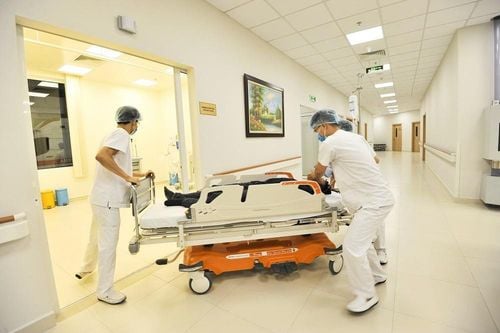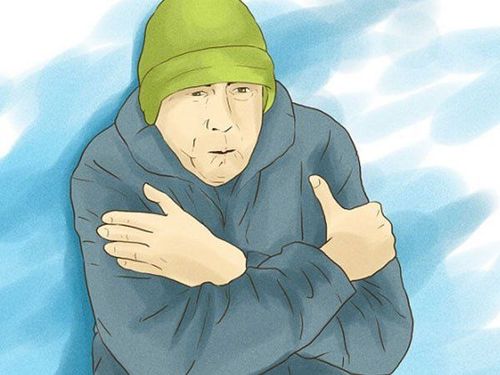This is an automatically translated article.
The article is professionally consulted by an Anesthesiologist - General Surgery Department - Vinmec Nha Trang International General Hospital.
Any state of hyperthermia or hypothermia affects vital organs. In particular, malignant hyperthermia syndrome is an example, a complication encountered during anesthesia, which is potentially life-threatening if not handled promptly.
1. What is malignant hyperthermia?
The human body is a constantly functioning machine. Whether sitting at rest or lying still, physiological transformations continue to take place, both creating energy and generating heat, maintaining a stable body temperature around an average value of 37oC. The rise or fall of body temperature are both unusual issues to be concerned about.When the body temperature is higher than normal, it is called hyperthermia. At this time, the heat generation process is strongly increased or the heat loss process is limited, or a combination of both. However, malignant hyperthermia is the result of metabolic attacks when patients are anesthetized with the volatiles halothane, isoflurane, enflurane, sevoflurane, desflurane, or a depolarizing muscle relaxant such as succinylcholine.
This syndrome occurs only in hypersensitive patients, the proportion of these subjects in the general population is about 1 / 30,000 cases of volatile anesthetics. In which, the number of men is more than that of women, the ratio is 2:1.
In general, malignant hyperthermia syndrome is an urgent condition, a complication of anesthesia, and threatens the patient's life if not promptly intervened.
2. What are the causes of malignant hyperthermia?
The stimulants to malignant hyperthermia observed so far in most cases have been attributed to the use of volatile anesthetics such as halothane, sevoflurane, and desflurane, with or without the combination with succinylcholine.When using these drugs for anesthesia and muscle relaxants during intubation, mechanical ventilation before surgery, if the patient is sensitive to the above agents, the phenomenon of increased metabolism in skeletal muscle cells will occur. abrupt with the mechanism of increased calcium influx into the endothelium.
From there, the body's body temperature will rise with a rapid rate and severity without control. This phenomenon has been observed to run in families with a dominant trait, which means that if a parent has had it before, there is a higher chance that their offspring will have it. At the same time, the initial steps of genetic analysis showed that there was more association with male sex than female sex.
In addition, malignant hyperthermia has also been reported in patients who exercised heavily or when exposed to high temperatures, but the mechanism of these cases remains unclear.

Tăng thân nhiệt ác tính cũng được ghi nhận trên những bệnh nhân tập luyện nặng
3. What are the manifestations of malignant hyperthermia?
Immediately after anaesthesia, consider malignant hyperthermia when the patient observes an increase in body temperature above normal accompanied by an increase in respiratory rate, rapid deep breathing, respiratory distress, and heart rate. rapid, arrhythmia.In which, a particularly remarkable sign is the whole body muscle spasticity. The affected muscle group starts with the maxillofacial muscle mass that makes the patient unable to open the mouth, then the large muscle mass at the base of the extremities will also stiffen and finally the trunk muscle group, the whole body will stretch.
If detected at a late stage, the body temperature is already very high at this time because this sign is often missed at first. By this time, the measured core body temperature can sometimes go up to 45oC or in some cases it has a very fast rate with 1oC increasing every 5 minutes. Hyperthermia increases metabolism, consumes more oxygen, and increases carbon dioxide emissions.
Not only that, the continuous and prolonged muscle contraction causes the dissolution of skeletal muscle, which also generates heat, inhibits heat loss as well as requires energy supply from cellular metabolism. The vicious circle further causes the endothelial environment to become acidic, structural disruption and cell necrosis.
If cell necrosis occurs in the myocardium, causing arrhythmias, decreased contractility, acute heart failure, cardiovascular collapse and cardiac arrest. If brain cells are affected, it will cause focal nerve damage, arm weakness, decreased reflexes, loss of sensation or if the respiratory center is damaged, the patient will suddenly die right on the operating table.
Nevertheless, malignant hyperthermia should be differentiated from acute attacks of other metabolic diseases such as thyroid storm, adrenergic release in pheochromocytoma, or the possibility of febrile hyperthermia. In perioperatively rapidly progressing sepsis, especially in abdominal emergency surgery, gastrointestinal and urogenital tract interventions have a very high risk of causing serious and serious infection.
However, it is easy to find a difference when these conditions do not cause muscle spasticity and acidosis is combined (both metabolic acidosis and respiratory acidosis). At the same time, the definitive diagnosis of hyperthermia with any mechanism should absolutely not delay the emergency procedure of malignant hyperthermia.
4. How to manage malignant hyperthermia?

Việc cần làm đầu tiên là sử dụng ngay dantrolene qua đường tĩnh mạch
The first thing to do is to use intravenous dantrolene immediately. This is the only antagonist to date for cases of malignant hyperthermia. Dantrolene exerts its potent inhibitory effect on skeletal muscle spasticity, thereby reversing intracellular metabolic acidosis within minutes of its presence in plasma.
As a result, the mortality rate from malignant hyperthermia decreased from 70% to only 1 to 17% when dantrolene was used. Therefore, this drug always needs to be fully stocked in operating rooms, on ambulances and ready for use at any time.
The next thing is to ensure adequate oxygen supply, optimize ventilation system. Simultaneously, the anesthesiologist should immediately notify the surgeon of the possibility of malignant hyperthermia and request consideration of discontinuation or prompt termination of surgery. In the event that surgery cannot be stopped immediately, the anesthesiologist must maintain anesthesia by switching to another class of drugs such as propofol that do not pose a risk of malignant hyperthermia.
Besides, it is necessary to quickly lower the patient's body temperature to below 38.5oC by means of physical cooling such as cool compresses, wipes... In addition, it is necessary to adjust hemodynamics, acidosis and after-effects. Other effects such as hyperkalemia, acute renal failure due to rhabdomyolysis by infusion of vasopressors, calcium, bicarbonate, insulin-glucose, fluid replacement, diuretics, electrolyte stabilization... until vital signs symptoms, tests returned to normal after the surgery, postoperatively, and in the days following.
Finally, because malignant hyperthermia is likely to recur in 1⁄4 of cases despite successful initial resuscitation, dantrolene should still be maintained at a low intravenous dose for 48 hours. after the last bout. Before discontinuing the drug, the patient should be reevaluated by the anesthesiologist to ensure that there is no risk of another exacerbation of hyperthermia.
Malignant hyperthermia syndrome is a complication of surgery with some volatile anesthetics. Early recognition and timely treatment can help prevent serious, life-threatening developments. Since then, surgical indications and anesthetic methods need to be extremely careful to avoid unintentionally causing unfortunate consequences.
Please dial HOTLINE for more information or register for an appointment HERE. Download MyVinmec app to make appointments faster and to manage your bookings easily.













